The Sandy Bridge Pentium Review: G850, G840, G620 & G620T Tested
by Anand Lal Shimpi on August 23, 2011 12:11 AM ESTThe Test
As always we're only presenting a subset of our entire CPU test suite here. For all of the numbers as well as other comparison options check out Bench.
| CPU: |
AMD A8-3850, AMD A6-3650, AMD Athlon II X4 635, AMD Athlon II X3 455, AMD Athlon II X2 265 Intel Core i3-2100, Intel Core i3 540, Intel Pentium G850, Intel Pentium G840, Intel Pentium G620, Intel Pentium G620T |
| Motherboard: |
Intel DH67BL (Intel H67) ASRock A75 Extreme6 (AMD A75) |
| Chipset Drivers: |
Intel 9.2.0.1025 AMD Catalyst 8.862 RC1 |
| Hard Disk: | Intel X25-M (80GB), Corsair P256 SSD (256GB) |
| Memory: | G.Skill DDR3-1866 2 x 4GB |
| Video Drivers: |
AMD Catalyst 8.862 RC1 Intel 2372 |
| Desktop Resolution: | 1920 x 1200 |
| OS: | Windows 7 x64 |
Adobe Photoshop CS4 Performance
To measure performance under Photoshop CS4 we turn to the Retouch Artists’ Speed Test. The test does basic photo editing; there are a couple of color space conversions, many layer creations, color curve adjustment, image and canvas size adjustment, unsharp mask, and finally a gaussian blur performed on the entire image.
The whole process is timed and thanks to the use of Intel's X25-M SSD as our test bed hard drive, performance is far more predictable than back when we used to test on mechanical disks.
Time is reported in seconds and the lower numbers mean better performance. The test is multithreaded and can hit all four cores in a quad-core machine.
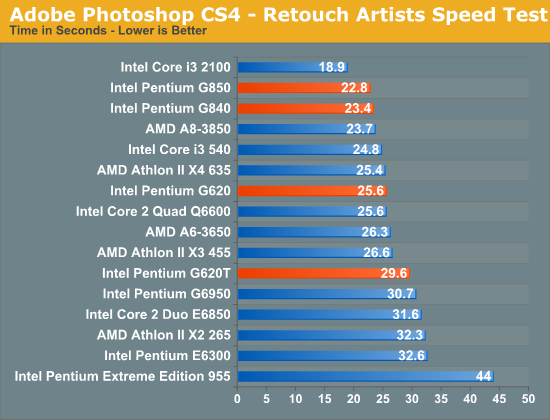
The Pentium G620 does a lot better than its Athlon II X2 counterpart, there's no contest here. The race is a lot closer between the G840/850 and the Athlon II X3 455, but in the end the Pentiums are faster. Both perform a bit better than the more expensive AMD A8-3850.
x264 HD Video Encoding Performance
Graysky's x264 HD test uses the publicly available x264 encoder to transcode a 4Mbps 720p MPEG-2 source. The focus here is on quality rather than speed, thus the benchmark uses a 2-pass encode and reports the average frame rate in each pass.
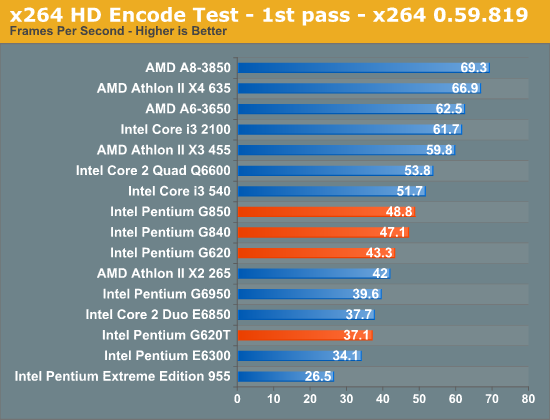
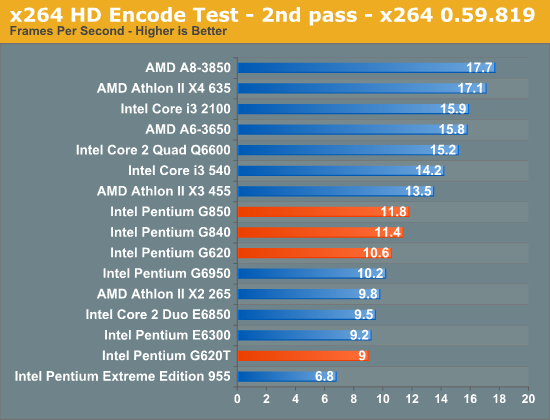
Once again the G620 is faster than the Athlon II X2 265 despite the latter's clock speed advantage. The G840 and G850 are faster than the 620 but not fast enough to overcome the extra core advantage of the X3 455. If you're spending $80 on a CPU for video encoding go for the Athlon II X3 455.
3dsmax 9 - SPECapc 3dsmax CPU Rendering Test
Today's desktop processors are more than fast enough to do professional level 3D rendering at home. To look at performance under 3dsmax we ran the SPECapc 3dsmax 8 benchmark (only the CPU rendering tests) under 3dsmax 9 SP1. The results reported are the rendering composite scores:
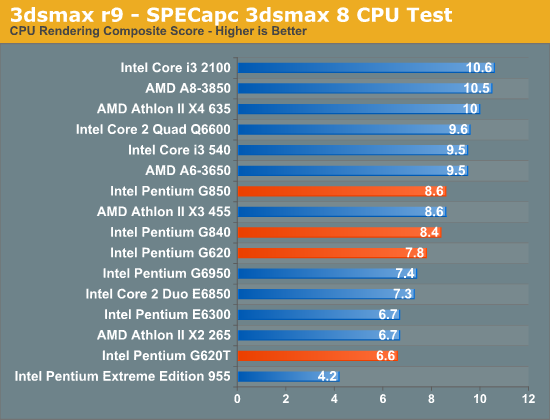
Not all heavily threaded tasks are going to favor more cores. In this case the IPC advantages of Sandy Bridge give the G850 equal performance to the X3 455.
Cinebench R10
Created by the Cinema 4D folks we have Cinebench, a popular 3D rendering benchmark that gives us both single and multi-threaded 3D rendering results.
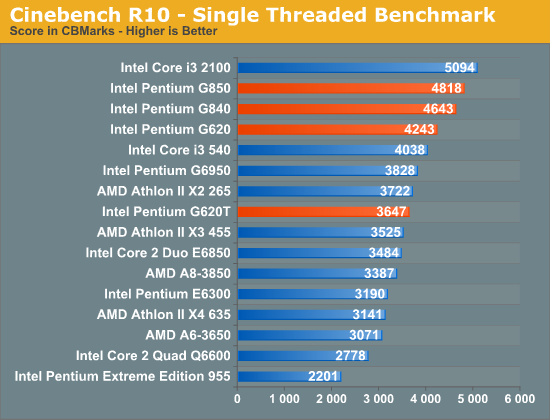
Single threaded performance is going to be a big advantage of the SNB Pentiums. Even the G620 is a good 14% faster than AMD's Athlon II X2 265 and the rest scale up with clock speed. What this translates to is great general use performance as well as solid performance in those apps that are still bound by the performance of a single thread.
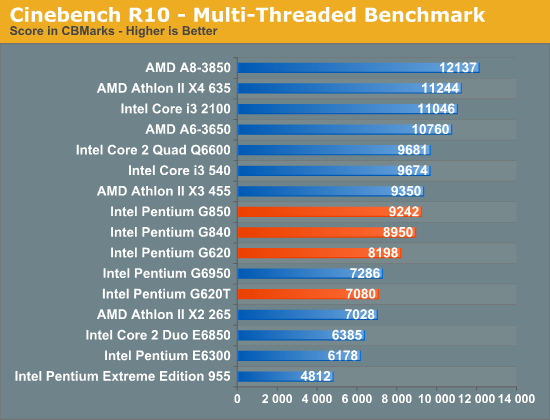
Multithreaded apps however start to benefit from more cores. In this case the Athlon II X3 455 isn't much faster than a G850 and only 4.5% faster than a G840, despite its core count advantage.
PAR2 Multithreaded Archive Recovery Performance
Par2 is an application used for reconstructing downloaded archives. It can generate parity data from a given archive and later use it to recover the archive
Chuchusoft took the source code of par2cmdline 0.4 and parallelized it using Intel’s Threading Building Blocks 2.1. The result is a version of par2cmdline that can spawn multiple threads to repair par2 archives. For this test we took a 708MB archive, corrupted nearly 60MB of it, and used the multithreaded par2cmdline to recover it. The scores reported are the repair and recover time in seconds.
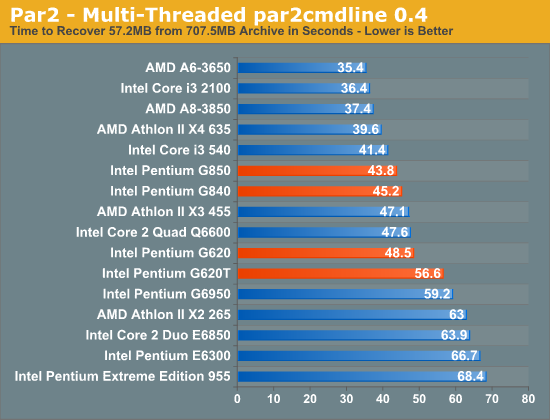
Our Par2 extraction test is another multithreaded scenario where two Sandy Bridge cores manage to slightly outperform three Athlon II cores. Whereas before it was a pretty simple "more cores, better multithreaded performance" argument, the SNB Pentiums do complicate things a bit.
WinRAR - Archive Creation
Our WinRAR test simply takes 300MB of files and compresses them into a single RAR archive using the application's default settings. We're not doing anything exotic here, just looking at the impact of CPU performance on creating an archive:
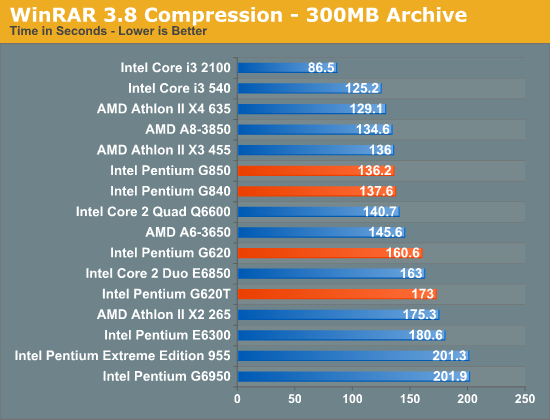
Once again we've got a multithreaded test with a murky outcome. The G850 is hot on the heels of the Athlon II X3 455, as is the G840.
Gaming Performance
Our first set of gaming performance results come using a discrete GPU. In the case of the Crysis Warhead results it's a GeForce GTX 280, while everything else uses a Radeon HD 5870. Across the board the Pentium manages to do better than its Athlon II competitors, of course with a discrete GPU that's not unexpected. Next we'll see how these stack up with processor graphics.
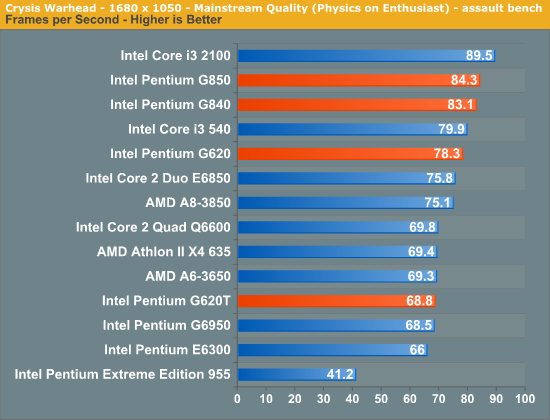
Dragon Age Origins is another very well received game. The 3rd person RPG gives our CPUs a different sort of workload to enjoy:
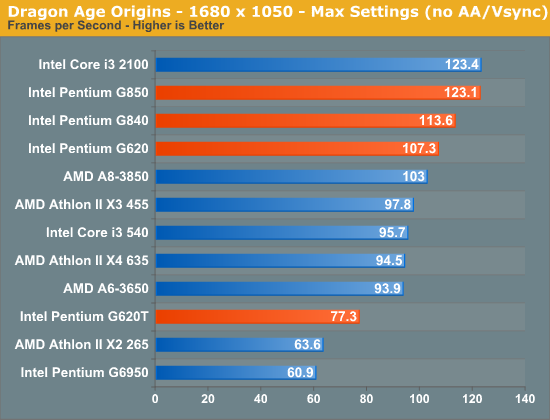
World of Warcraft needs no introduction. An absurd number of people play it, so we're here to benchmark it. Our test favors repeatability over real world frame rates, so our results here will be higher than in the real world with lots of server load. But what our results will tell you is what the best CPU is to get for playing WoW:
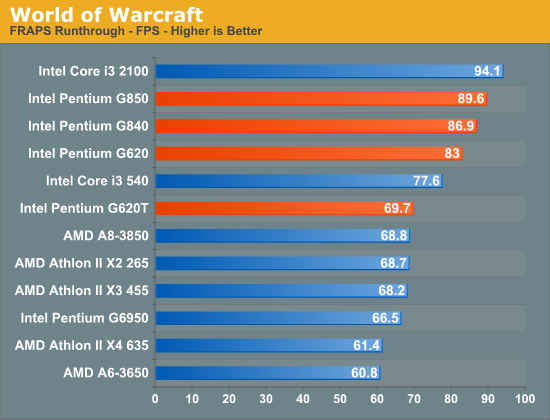
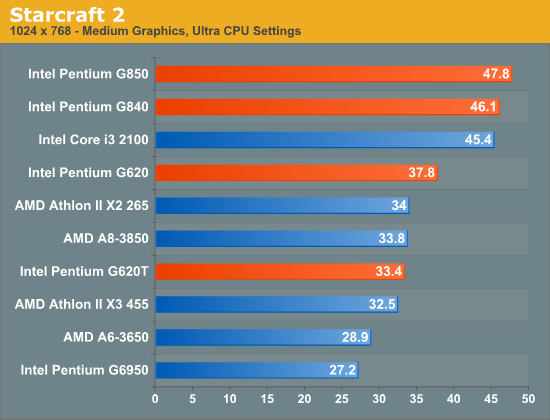
Power Consumption
The new Pentiums draw very little power, not only compared to their AMD counterparts but also the rest of the Sandy Bridge lineup.Without Hyper Threading, overall execution resource utilization is lower and thus power consumption is lower. It doesn't look like any of these chips come close to hitting their max TDPs as the Pentium G620T only draws 4W less than the G620 despite being rated with a 30W lower TDP.
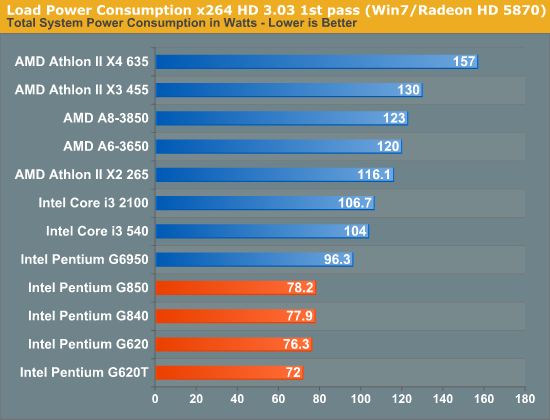










110 Comments
View All Comments
Taft12 - Tuesday, August 23, 2011 - link
People who visit AT are the last holdouts of the desktop PC generation.philosofool - Wednesday, August 24, 2011 - link
Businesses and schools. Or, about half the market for computers.alent1234 - Tuesday, August 23, 2011 - link
last year i bought a $299 laptop as a gift for someone. it's more than enough for that person.i actually wanted to buy them an ipad but my wife said laptop
Yowen - Monday, August 29, 2011 - link
Yeah, for personal use that's fine, but I'd love to run it for the hours that I run my desktop at work and see how long it lasts. So there is still a very sizable market for desktops.averik - Tuesday, August 23, 2011 - link
I don't think so. We recently bought 24 G620 Pentiums to replace socket 478 Pentium 4s in 2 highschools.The CPU market for doing "basic staff" is quite large, and its impressive that G620 is almost as powerful as the Core 2 E8500 which had a release price of $266.
philosofool - Wednesday, August 24, 2011 - link
Exactly.This review is naturally targeted at the single user building his own system.
If you're a public library or a high school or a medium sized office looking to upgrade 20 computers that are running 9am to 9pm daily, a 35W pentium destroys the competition. A 100W anything is a waste of money because the extra 1300W power consumption bites would cost you quite a lot of money in electricity. The power company charges a lot more when you're consuming a lot of power (like a business) than when you're consuming a little (like a home.)
yankeeDDL - Thursday, August 25, 2011 - link
Guys, please, let't be serious.You cannot possibly do considerations on power consumption by looking at a chart showing the power under load, do you?
If you do, then you should have bought Atoms: at 9W they're for sure much better than any Athlon and G*.
So why didn't you buy an Atom instead? Exactly, because it's slow.
What good does it make to use less power, if it takes you longer to do the same thing?
The G620, under load, consumes about 55% of the Athlon X3, but the Athlon takes 60% of the time that the G620 takes to do the same task (I'm looking at the x264 charts). So the difference between these two, under load, is anecdotal, at best.
So, I'm sorry for your highschools, but you did not save them much money in electricity. Infact, considering how more expensive the MoBos for SB are, you probably ended up making them pay more.
averik - Monday, August 29, 2011 - link
Cost of Athlon X3 + cheap Asus mboard = Cost of G620 + cheap Asus H61 mboard (about 125 Euros).Athlon X3 is a great CPU and in fact I use one at work. But most of the time CPUs are idle. We dont do any x264 work. In fact, i believe the typical hardest daily job of a CPU is to startup windows, antivirus etc.
In the low badget market you cannot go awfully wrong, so even Athlon X2 is a good choice, but AMDs line is aged. Pentium G*s on the other hand offer comperable performance at same price on a newer platform.
yankeeDDL - Friday, September 2, 2011 - link
Averik,respectfully, I disagree.
From Newegg: Biostar N68S = $40, Ath II X3 440 = $65
Biostar H61ML = $50 G620 = $75
Delta: $20 (out of $105, it's ~20%).
Note: the MoBos are the cheapest I found. The one for AMD also has onboard Video, saving you a few extra bucks if you don't do gaming.
If you are an extremely "light" user (email + web browsing), then neither the G620 or the Athlon X3 make much sense: Brazos (either the E-350 or the C-50) make a lot more sense, since their power consumption is abismal compared to the other two, and they pack plenty of speed for those tasks. Plus, the on-chip GPU accelerates web content nicely.
If you add to the mix some casual gaming, Brazos can even handle it, but it won't compare with either the Athlon of the G620. If you trust Tom's hardware, you can see that they recommend the X3 easily, because of the 3rd core, which helps in several scenario, despite the lower efficiency over the 2 cores of the G620.
I can imagine only some very, very specific scenarios (very limited budget, low PSU capacity, occasional gaming, lots of encryption) where the G620 has a slight edge over the X3, but that's far from average Joe budget PC.
You're totally right about not going "awfully" wrong with the G620, nevertheless, you do pay the "Intel" brand price over a slightly less performing CPU.
You're also right about AMD line being aged, but again, if you are looking at G620, you are looking into budget-oriented systems: not something you change every other day, so what is wrong wit being aged? In my view, you can find tons of good combo deals, and maybe even used parts, which could dramatically drop your costs.
Also, Intel isn't exactly famous for keeping things compatible: it wouldn't be the 1st time that the socket gets quickly outdated (was it really necessary to have a socket 1156 and an 1155?), while AMD's socket gets you covered up to the Phenom II X4, for a dirt-cheap bump in performance.
That's the way I see it at least. I would love to see the prices of the G620 going below $50: that would be a real deal (and I'm sure would push AMD's prices even lower). Till that happens, for budget, I buy AMD, which gives the best bangs for the bucks.
averik - Sunday, September 4, 2011 - link
yankeeDDL, I agree with many of your points (especially changing sockets). Please note however that best prices or used items are not an option for some buyers.The scenario is extremely light use (email, web browsing, ms office, thin-client intranet applications, light educational applications), but the investment has to last for 5-10 years (we are replacing P4s - I know its a shame). I am not sure how heavily threaded the environment will be in then. If it is, then yes, Athlon X3 will perform a bit better. If not, then G620 having better single-thread performance will be better. Both will be old though.
I also found the case of E350 very interesting - to replace bulkier equipment with ITX motherboards and small cases - so I built one for home and use it daily. My conclusion is something like Brazos will be a good mid-term investment for basic office use if (1) they get 50% better CPU power (graphics are ok) and (2) availability of PSUs for ITX cases gets better - I mean it should be as trivial to find a replacement as a regular PSU is. But sure, thats the way of things to come.
As for G620 going below $50, I dont have high hopes. Maybe the cheapest Bulldozers (when they appear) will force Intel to do that - but why go for G620 then?
I really liked reading your comments.